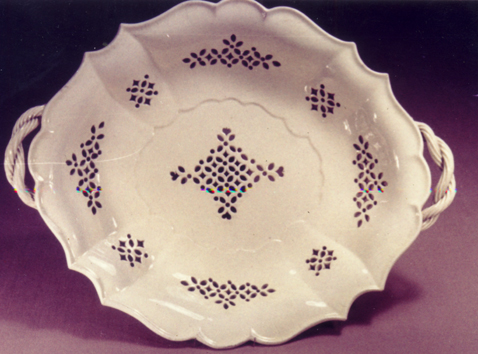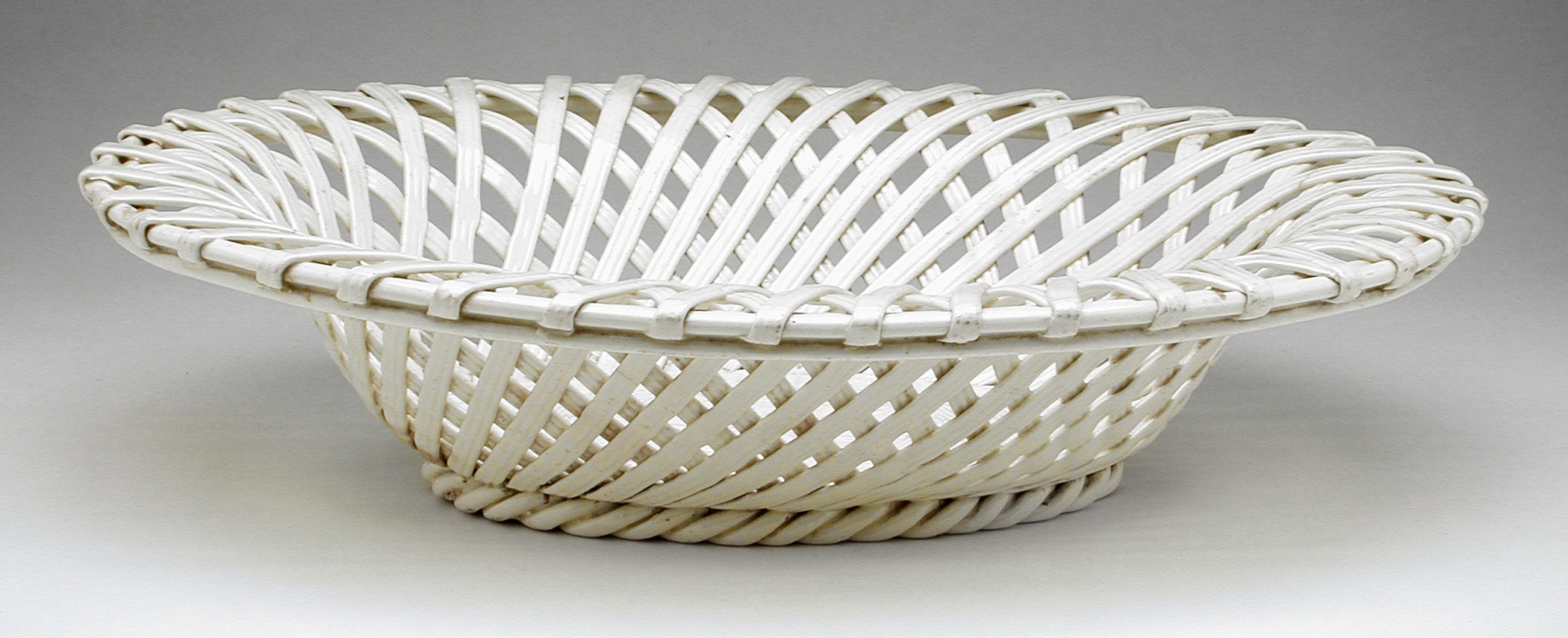The Leeds Pottery was probably established in 1770 in Jack Lane, Hunslet in South Leeds by Richard Humble and Joshua and John Green. The company had a complex history. Around 1783 William Hartley joined the company, which became Hartley Greens & Co. In the early 19th century the company suffered financial difficulties and went into decline. After 1821 the business was sold several times, becoming Wainwright & Co, Stephen & James Chappell, Warburton & Britton, and Richard Britton & Sons, who were the owners when it closed in 1881.
The pottery is most notable for its creamware, fine glazed pottery with intricate pierced patterning and decorative detail, often called Leedsware. Black Egyptian ware, red earthenware with a black glaze was also made.
History
The Leeds Pottery or Old Leeds Pottery was one of a cluster of potteries that opened in Hunslet and Holbeck south of the River Aire in Leeds in the 18th and 19th centuries.[1] It was most probably established in 1770 when Richard Humble bought a five and a half acre plot on Rushey Pasture on Jack Lane in Hunslet. Humble, John and Joshua Green insured their pottery in 1771 for £1,000. In 1771 the company traded as Humble, Green & Co and after William Hartley became a partner it was styled Humble, Hartley, Greens & Co. Humble, who was also agent for Brandling’s Middleton Colliery resigned in 1781.[2]
First cousins, Savile and Joshua Green and Joshua’s son John were all involved in the pottery. John Green was described as a “potter of Hunslet” and probably ran the works. He sold his shares in the 1790s. Joshua Green “gentleman” died before 1799 and his heir Ebenezer Green remained at the pottery until 1820.[3] Businessman William Hartley joined the company from Colne in Lancashire, after his death in 1813 he was succeeded by his son William. The pottery had several other shareholders.[4]
As built in 1770, the pottery was large. In 1775 the company leased the mill on the River Wharfe at Thorp Arch to grind flint until the windmill adjacent to the pottery was refurbished.[a]Built as a corn mill and converted by Leeds Potteries to grind flints using German stones in 1774.[5] In 1785 the Leeds Pottery amalgamated with the Swinton PotteryFounded in 1745 and renamed the Rockingham Works in 1826, the company produced fine porcelainware until 1842. with John Green in charge of both. The pottery manufactured its finest products before 1800 and they were exported to France, Spain, Holland Germany and Russia. Decline set in after 1800 and in 1806, friction between the potteries caused the Leeds partners to withdraw. The Leeds Pottery closed for a time in 1810 but by 1813 had reopened.
Finances were strained and the pottery was offered for sale in 1826.[6] At that time the pottery comprised four biscuit and eight glazing kilns, hardening and enamel kilns, sliphouses, workshops and a flint mill. It remained unsold until 1830.[6] It was again offered for sale but not sold until 1843 when it was bought by the manager, Stephen Chappel.[7]
After Chapel’s death the company had insufficient money to pay its creditors and in 1849 was offered at auction. Between 15 and 20,000 dozen pieces of earthenware pottery, blue clay, china clay, cream coloured glaze, enamel colours, moulds and 17 printing presses were offered in the sale.[7] The sale included five gloss kilns, three biscuit and four hardening kilns, blue and china clay, ground flint and stone, cream coloured glaze, soda, underglaze and enamel colours.[7]
The pottery was bought by Richard Britton who took Samuel Warburton as a partner. After Warburton’s death in 1872 the company traded as Richard Britton & Sons.[7] This company also went bankrupt and its premises were taken over by the Middleton Estate and Colliery Co and remained empty until Joseph Wilson Taylor took over but after a few months it again closed.[8]
Wares
Twelve drawing books, three in the Victoria & Albert Museum and nine at Leeds Central Library have survived. The Leeds books were compiled between about 1781 and 1819.[9] The best period aesthetically for the pottery was from its inception until the first decade of the 19th century as later products were for the domestic market. Among the early wares were red earthenware, salt-glazed stoneware, black ware as produced at Jackfield and most importantly the creamware that is also known as Leedsware. Early pieces of creamware were a deeper shade of cream with a yellow tinted glaze.[10] Much creamware was plain but a small amount was painted with enamels. In 1775 Cornish clay and stone resulting in a paler shade of cream. About this time pieced work was introduced.[11]
Figures were made after 1790, mostly in pearlware with characteristic snub-nosed faces and receding chins.[11] Leeds ware was much copied. Transfer printing was introduced in about 1780, first in black and brick red, then blue.[12] Egyptian blackware was made around 1800. Little is known of what the later occupants produced but it was probably utilitarian for the domestic market.[8]
Richard Britton made earthenware for the domestic market and much was sent to London. The pottery still made “Rockingham ware”, black glazed ware and yellow earthenway from clay brought from nearby Wortley. Some bricks were also made.[13]
Leeds City Council restarted the brand in 1983, making reproduction pieces, but had to sell the business. Production was moved to Stoke-on-Trent, and in 1992 after it was acquired by John Croft it was renamed Hartley Greens & Co. In 2011 it was acquired by Denby Pottery and production moved to Middleport Pottery, Stoke-on-Trent.[14]


